#elearning development solutions
Explore tagged Tumblr posts
Text
Boost Learning & Development with Instructional Design
Explore how instructional design services play a key role in enhancing employee learning and development. This blog by 42 Design Square dives into the benefits of effective instructional design—from creating learner-focused content to leveraging technology for engagement. Learn how businesses can utilize eLearning development solutions to foster a more skilled and agile workforce. Whether you're launching a new training initiative or improving existing programs, instructional design can maximize impact and ROI. Discover proven strategies to align learning goals with business objectives and drive long-term growth through well-structured, impactful training modules crafted by eLearning experts.
0 notes
Text
IETM for Beginners A Quick Guide to IETM Code and Pixels
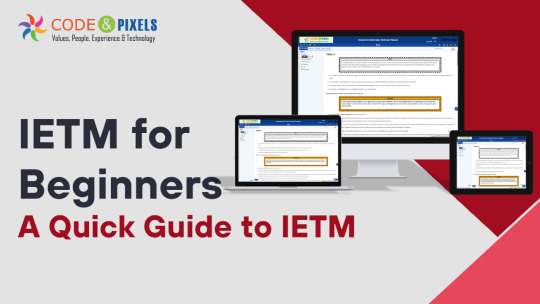
IETM: Interactive Electronic Technical Manual
Training Aids to Defence Client
If you are a supplier of defence then along with the system/equipment you also need to provide Training Aids
(CBT) — Computer-Based Training
Charts and Bloups
Video Film
Training Work Modules
Manuals Hard Copies
IETM
Evolution of Documentation in Defence
Before — Hardcopies and PDFs in DVDs (Upto 2015)
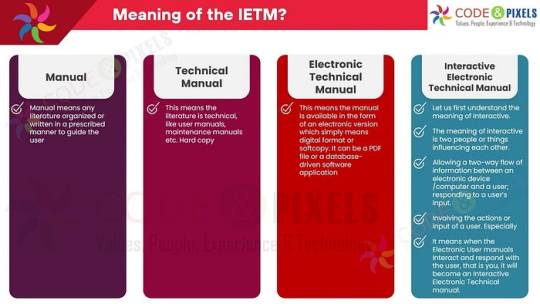
What is the meaning of the IETM?
Manual: Manual means any literature organized or written in a prescribed manner to guide the user.
TechnicalManual: This means the literature is technical, like user manuals, maintenance manuals etc. Hard copy
Electronic Technical Manual: This means the manual is available in the form of an electronic version which simply means digital format or softcopy. It can be a PDF file or a database-driven software application.
Interactive Electronic Technical Manual:
Let us first understand the meaning of Interactive. The meaning of interactive is two people or things influencing each other.
Allowing a two-way flow of information between an electronic device /computer and a user; responding to a user’s input.
Involving the actions or input of a user. Especially
It means when the Electronic User manuals Interact and respond with the user, that is you, it will become an Interactive Electronic Technical manual.
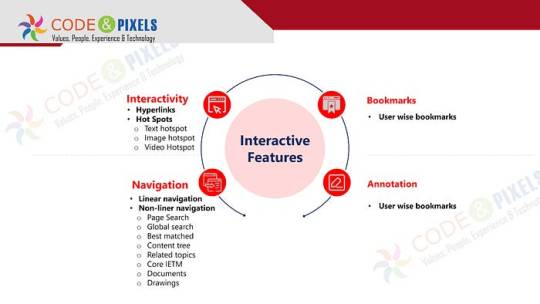
Interactive Features
Interactivity
Hyperlinks
Hot Spots
Text hotspot
Image hotspot
VideHotspot
Bookmarks
User wise bookmarks
Navigation
Linear navigation
Non-liner navigation
Page Search
Global search
Best matched
Content tree
Related topics
Core IETM
Documents
Drawings
Annotation
User wise bookmarks
The documents and pages are many hence, for easy and fast accessibility complete content is converted and stored as a database.
Whenever the user wants some information, IETM software produces the information in a fraction of a second.
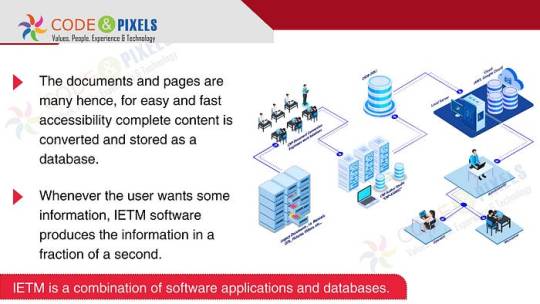
Use or Purpose of the IETM?
The purpose of the Manual is to give information related to the equipment to the end user for quick reference.
All the technicality is written in detail so that when an issue arises, the user can refer to the manual, as every time OEM or technical person or subject matter expert might not be available on the spot to resolve the issue.
If the manual has 10 pages users can refer easily.
But any system used by the defence will have multiple manuals and thousands of page counts and many times a user has to cross-refer between manuals, intra-manual and inter-manual to resolve the issue.
Referring to 10- 15 hard-copy or even soft-copy books simultaneously will be difficult and time-consuming.
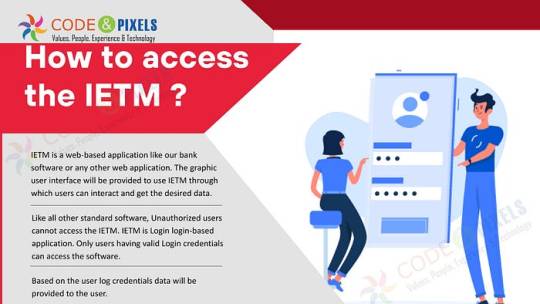
How to access the IETM ?
IETM is a web-based application like our bank software or any other web application. The graphic user interface will be provided to use IETM through which users can interact and get the desired data.
Like all other standard software, Unauthorized users cannot access the IETM. IETM is a Login - login-based application. Only users having valid Login credentials can access the software.
Based on the user log credentials data will be provided to the user.
IETM has 2 types of Users and one Administrator
Maintainer
Operator
If the operator logs in, the user gets all the content related to operator use, similarly if the maintainer logs in only maintenance-related content is visible for that user.
Ideally, all the content is available for both users, because the purpose of the IETM is to refer to the manual to fix the issue.
Administrators can create users who can see the user’s navigation and log-in history and interact with the users using user dashboards through Annotations.
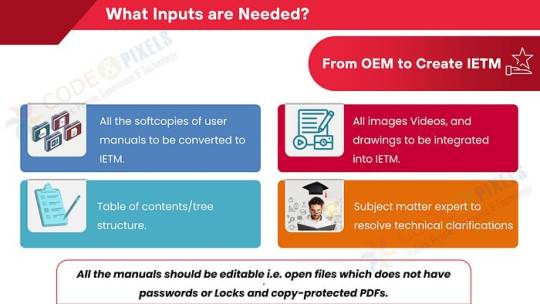
What Inputs are Needed? (From OEM to Create IETM)
All the softcopies of user manuals to be converted to IETM.
All images Videos, and drawings to be integrated into IETM.
Subject matter expert to resolve technical clarifications
Table of contents/tree structure.
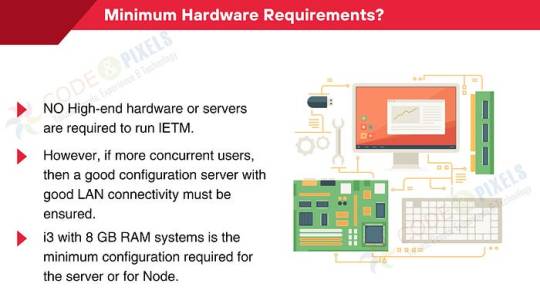
Minimum Hardware Requirements?
NO High-end hardware or servers are required to run IETM.
However, if more concurrent users, then a good configuration server with good LAN connectivity must be ensured.
i3 with 8 GB RAM systems is the minimum configuration required for the server or for Node.
Deliverables
BASED DB (Manuals are covered in the Database)
IETM VIEWER Software
User Manual and Installation Manual
Standards — compliance
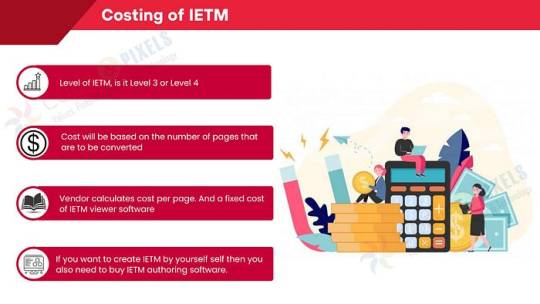
Costing of IETM: (Interactive Electronic Technical Manual)
Level of IETM, is it Level 3 or Level 4
Cost will be based on the number of pages that are to be converted
The vendor calculates the cost per page. And a fixed cost of IETM viewer software
If you want to create IETM by yourself self then you also need to buy IETM authoring software.
What are these Levels?
Level — 1 is any PDF file
Level — 2 is a PDF file with hyperlinks from the table of contents to the body etc.
Level — 3 is an HTML application. More hyperlinks, simple search, a content tree having log a screen with a hardcoded username and password and supplied in the format of EXE so that Windows can easily open
Level — 4 is Software plus Content/manuals converted as Database
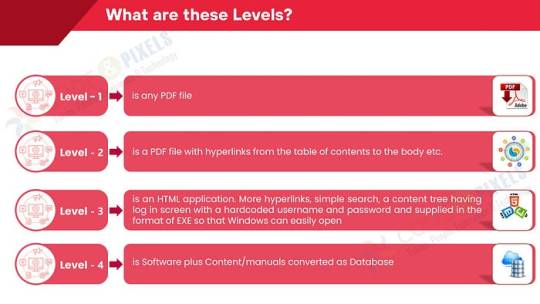
Regarding Level — 5, rest assured, till 2028 it will be Level — 4 only. As of now, there is nothing practically called Level — 5. Few are calling virtual reality and Augmented reality and Artificial intelligence Level — 5.
Pulling data from many user inputs and analyzing and giving results are done in Level — 5. IETM software cannot pull the data from various real-time points as No OEM will give the real-time information to third-party software directly. Yes, if the information is available offline, then that information can be imported into IETM and can be used as a reference.

#ietm#software#technology#ietm developement#ietm code and pixels ietm hyderabad#ietm software#elearning#code and pixels#ietm level iv#codeandpixels#ietm level 4 software requirements#technical documentation#ietm document#ietm documentation#interactive electronic technical manual#Ietm Service Providers#Ietm Software Designers of India#Software Development Company#Elearning Solutions Company#E Learning Content Development Company#Online Education#Digital Education#Digital Content#Software Development Solutions#Elearning#Ietm Developers#Econtent Development#Elearning Solutions Providers#Econtent Developers#Econtent
3 notes
·
View notes
Text
Leadership development courses - Infopro Learning
Elevate your leadership skills with tailored leadership development courses by Infopro Learning. Unlock your full potential and excel in your industry For more information visit our website www.infoprolearning.com.
1 note
·
View note
Text
0 notes
Text
HR Compliance Software Solutions help businesses manage and automate regulatory compliance, ensuring adherence to labor laws, workplace policies, and industry standards. These solutions provide real-time monitoring, document management, audit trails, automated reporting, and risk assessment tools to minimize legal risks and enhance HR efficiency.
With features like employee record management, policy updates, e-signatures, and built-in compliance alerts, businesses can stay up to date with ever-changing regulations. Whether for small businesses or large enterprises, HR compliance software simplifies complex processes, reduces errors, and fosters a legally compliant work environment. Location
United States 2G Auer Ct,East Brunswick, New Jersey 08816
India 3rd Floor Main Building Rear, Guna Complex, Anna Salai, Teynampet, Chennai 600018
Contact Us
+91 638 375 5273
#HR Compliance Software Solutions#Corporate Elearning Solutions#Human Resource Software Solution#HR Compliance Training For Employees#HR Compliance Courses#Regulatory compliance training#Upskilling programs#Corporate training solutions#Workforce development programs#HIPAA training for healthcare workers#SEVnest
0 notes
Text
How AI is Enhancing the eLearning Experience with Personalized Content, Assessments, and Feedback
In the rapidly evolving world of eLearning, the integration of Artificial Intelligence (AI) is transforming the way learners experience online education. From custom eLearning development to sophisticated learning and development solutions, AI is providing educators and organizations with powerful tools to deliver personalized content, create tailored assessments, and offer actionable feedback. Let’s explore how AI is enhancing the eLearning experience and shaping the future of education.

1. Personalized Content: Tailoring Learning to Individual Needs
One of the most significant advantages of AI in eLearning is its ability to create personalized learning experiences. In traditional education settings, learners often follow a one-size-fits-all approach, which can leave some students behind while others may not be challenged enough. With AI-driven custom eLearning development, however, learners can receive content that adapts to their individual learning styles, progress, and needs.
AI systems can analyze learner behavior and identify areas where they excel or struggle. Based on this data, AI-powered platforms can dynamically adjust the content, presenting more challenging material when learners are ready or revisiting concepts they haven’t fully grasped. This personalization increases engagement, retention, and learner satisfaction, making the learning process more efficient and impactful.
2. Smarter Assessments: Tailored Testing for Better Learning Outcomes
AI is revolutionizing how assessments are designed and delivered in eLearning. With traditional assessment models, learners typically encounter standardized tests that don’t account for individual learning needs or progress. AI-based assessments, however, offer a more dynamic approach. By analyzing data from ongoing coursework, AI can create custom quizzes, exams, or tests that adapt in real time to a learner’s proficiency level.
For instance, an AI-powered system may adjust the difficulty of questions based on previous answers or provide more targeted questions to reinforce weak areas. This tailored approach not only helps learners stay engaged but also allows instructors and learning and development solutions teams to better measure each learner’s true understanding. Additionally, AI can provide insights into common knowledge gaps, allowing organizations to fine-tune their learning content.
3. Instant, Actionable Feedback: Helping Learners Improve Continuously
Feedback is an essential part of the learning process, but providing timely, constructive feedback at scale can be challenging. AI makes this process much more efficient. Instead of waiting for a human instructor to grade assignments and provide feedback, AI-powered systems can offer instant, actionable feedback on quizzes, assignments, and interactive learning activities.
For example, if a learner answers a question incorrectly, the AI system can immediately explain why the answer was wrong and provide hints or resources to help them improve. This immediate feedback loop encourages continuous learning and ensures that learners stay on track without long delays. Furthermore, AI can identify patterns in learner mistakes and suggest additional resources or study materials tailored to specific weaknesses, creating a more effective and individualized learning experience.
4. Enhanced Learning Pathways: Dynamic Course Adjustments
AI not only customizes content but also adjusts entire learning pathways to suit individual learners. AI-powered learning and development solutions can track a learner’s progress over time and make real-time adjustments to their learning trajectory. For example, if a learner is excelling in certain areas, the AI system can introduce more advanced topics or courses, allowing them to move ahead at their own pace. On the other hand, if a learner is struggling, the system can offer additional review material or recommend remedial lessons to reinforce key concepts.
This dynamic approach helps create a more efficient learning journey, enabling learners to move at their own speed while ensuring they master the necessary skills and knowledge. For businesses, it provides an opportunity to create agile learning and development programs that can adapt to the evolving needs of employees.
5. Data-Driven Insights: Optimizing Learning Experiences
One of the most powerful aspects of AI in eLearning is its ability to generate and analyze vast amounts of data. Learning platforms powered by AI can gather insights on how learners interact with content, which resources are most effective, and where learners tend to struggle. This data is invaluable for continuous improvement in custom eLearning development and overall learning program design.
AI can also offer predictive analytics to forecast which learners may need additional support before they even struggle. By recognizing trends early, organizations can implement timely interventions to improve learner outcomes, reduce dropout rates, and enhance overall program success.
6. Cost and Time Efficiency in eLearning Development
AI is also playing a pivotal role in making eLearning more cost-effective. Through automation, AI can streamline content creation, assessment generation, and feedback processes, reducing the need for extensive human resources. Custom eLearning development teams can focus their efforts on high-level tasks, while AI handles repetitive or time-consuming aspects of course design and delivery.
For organizations looking to scale their learning and development solutions, AI offers the ability to deliver high-quality, personalized learning experiences to a large number of employees without the need for individualized, time-intensive oversight.
Conclusion
AI is undeniably reshaping the eLearning landscape. Through personalized content, dynamic assessments, instant feedback, and data-driven insights, AI is improving the quality of education and training experiences for learners across industries. Organizations that integrate AI into their custom eLearning development and learning and development solutions can offer a more effective, engaging, and personalized learning journey, fostering better results for both individuals and organizations alike. As AI continues to evolve, the future of eLearning looks more exciting and promising than ever before.
By leveraging AI, educators and businesses can create intelligent, adaptive, and scalable learning environments that meet the unique needs of each learner, ensuring their success in today’s fast-paced world.
0 notes
Text
Enhancing Moodle™ Functionality with Custom Plugin Development
As online learning continues to expand, educational institutions and businesses seek innovative ways to improve their learning management systems (LMS) for a more engaging user experience. Moodle™ stands out as a robust, open-source LMS that provides extensive capabilities. However, with custom plugin development, Moodle™ can be tailored even further to meet specific needs, improve user engagement, and enhance functionality. In this article, we’ll explore the benefits of custom plugins for Moodle™, including how they can support branded app development, course management, data analytics, and more.
1. Why Custom Plugin Development for Moodle™?
Custom plugin development transforms Moodle™ from a general-purpose platform into a tailored solution, meeting unique organizational requirements. From enabling offline access to offering a user-friendly interface, custom plugins allow organizations to add or modify features to align perfectly with their needs. This can be particularly valuable for institutions aiming for a branded experience, as custom branding apps can showcase their brand identity within the learning platform.
2. Enhancing Course Management and User Engagement
Course management is at the core of any LMS, and Moodle™ is no exception. With custom plugins, organizations can streamline the course setup process, add new course formats, and even offer personalized learning paths. Plugins designed for course management also help instructors and admins manage large courses effectively, ensuring a smoother learning experience for students.
An optimized course management process leads to higher engagement and retention. Features like real-time communication plugins allow students and instructors to interact instantly, creating a collaborative learning environment. Adding plugins that support multi-device compatibility ensures that users can access course content seamlessly, whether they’re on a desktop, tablet, or smartphone.
3. Branded App Development for Moodle™
For organizations looking to create a unique identity, branded app development for Moodle™ offers a powerful solution. Through branded apps, institutions can provide learners with an app that not only matches their brand's look and feel but also offers all necessary Moodle™ functionalities. With Moodle™ software app development, businesses can ensure their platform reflects their brand’s values and aesthetics, fostering a stronger connection with learners.
By incorporating plugins that allow customizable features, branded apps can be fine-tuned to prioritize certain functionalities, like quick access to course content or communication tools. Custom plugins also help optimize the app for performance and usability, resulting in a superior user experience.
4. Offline Access and Multi-Device Compatibility
One of the common challenges in e-learning is ensuring that users have access to content regardless of their internet connection or device. With custom plugins, Moodle™ can be equipped to support offline access, allowing users to download content for later use. This functionality is particularly beneficial for users in remote areas or for students who need flexibility in accessing learning materials.
Furthermore, multi-device compatibility is essential in today’s mobile-first world. Custom plugins can ensure Moodle™ functions seamlessly across different devices, from desktops to smartphones, enhancing accessibility for all users.
5. Improving User Experience with a User-Friendly Interface
A user-friendly interface is key to keeping learners engaged. Custom plugins can be developed to simplify navigation, making it easier for users to find what they need. Plugins focused on creating a user-friendly interface can transform Moodle™ by optimizing the layout, reducing clutter, and adding visual cues that improve usability.
6. Strengthening Security and Privacy
Security and privacy are critical considerations in any online learning platform. Custom plugins can be designed to enhance security and privacy features in Moodle™, ensuring that user data is protected. From additional login verification methods to restricted access for sensitive information, plugins can bolster the security framework of Moodle™, building trust with users.
7. Leveraging Data Analytics for Informed Decision-Making
Custom plugins that offer data analytics are invaluable for tracking learner progress, identifying patterns, and making data-driven decisions. With data analytics plugins, institutions can gain insights into course performance, learner engagement, and completion rates. These insights can then guide improvements in course content and teaching methods, optimizing the learning experience.
8. Integration with Third-Party Tools
Another advantage of custom plugin development for Moodle™ is the ability to integrate with other tools and software. From integrating with communication platforms to data storage and CRM systems, integration with tools via plugins helps streamline processes and create a cohesive learning ecosystem. These integrations allow Moodle™ to work in harmony with other platforms, enhancing overall functionality and user convenience.
9. Regular Updates for Continuous Improvement
Custom plugins allow organizations to keep their Moodle™ platform up-to-date with the latest features. Regular updates to plugins ensure that Moodle™ remains compatible with new technologies and user expectations. Moreover, with custom plugins, organizations can adapt and evolve their LMS to address emerging trends in e-learning, providing learners with a modern and relevant experience.
Conclusion
Custom plugin development enhances Moodle™ functionality by tailoring it to meet specific needs. From branded app development to data analytics and security enhancements, custom plugins transform Moodle™ into a more versatile and powerful LMS. By adopting custom plugin development, organizations can create a unique, engaging, and effective learning platform that aligns with their branding and goals. Embracing these customized solutions ensures a user-centered, accessible, and future-ready LMS experience.
#Custom Plugin Development#Moodle™ Customization#Learning Management Systems (LMS)#Branded App Development#Course Management#User Engagement#Data Analytics#Security and Privacy in LMS#Offline Access in Moodle™#Multi-Device Compatibility#User-Friendly Interface#Third-Party Tool Integration#LMS Optimization#eLearning Solutions#Digital Transformation in Education#Educational Technology#Personalized Learning
0 notes
Text
On-demand and Customized Learning Management System
Tecnolynx designs adaptive learning pathways through a personalized, reliable, and user-friendly learning management system (LMS) platform. Our skilled developers excel in creating custom LMS solutions, handling integration, and overseeing implementation, all tailored to fit your unique learning requirements.
Looking for a powerful LMS solution? Connect with Tecnolynx for a customized and robust learning management system tailored to your needs.
#Learning Management System (LMS)#eLearning solutions#LMS development#Customized eLearning platforms#Online training software#Virtual learning environments#Educational technology solutions#Learning content management system (LCMS)#Interactive learning experiences#Personalized learning platforms
0 notes
Text
Custom eLearning Solutions for Effective Learning and Development
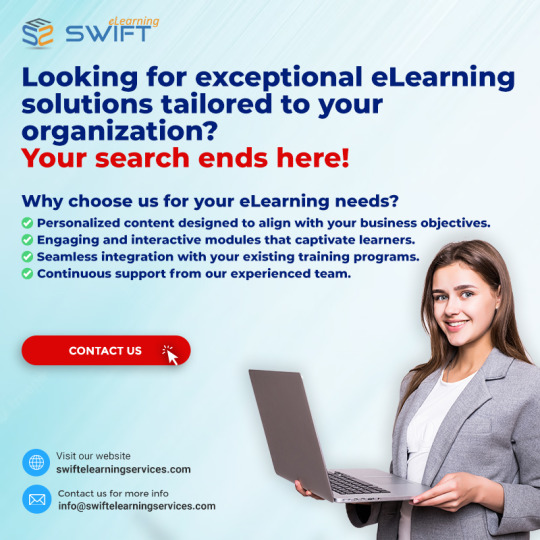
Custom eLearning solutions design interactive, engaging courses tailored to meet your specific training needs at competitive prices.
Our eLearning Solutions:
Rapid eLearning
Blended Learning
Legacy Content Conversion
Translation & Localization
Learning Management System (LMS)
Human Resource Management System (HRMS)
What is Custom eLearning?
Custom eLearning provides personalized online courses that cater to the unique needs of learners and organizations. Our goal is to enhance training effectiveness and maximize return on investment (ROI).
The transition from ILT/VILT to eLearning: Convert classroom-based training into SCORM and HTML5 content for interactive, accessible learning.
Microlearning Solutions: Bite-sized modules designed for on-the-go learning to improve quick knowledge retention.
Game-Based Learning Solutions: Engage learners through interactive, game-based learning strategies for effective knowledge transfer.
eLearning Content Development
We offer tailored learning experiences designed to meet specific objectives and learner needs.
Rapid eLearning: Quick, efficient course development using rapid authoring tools.
Blended Learning: Seamlessly integrates in-person and online learning for a balanced training approach.
Custom eLearning Samples
Explore our diverse range of custom eLearning solutions that enhance employee skills through interactive modules and simulations.
Content Conversion Solutions
Legacy Content Conversion: Modernize outdated materials into digital formats.
Flash to HTML5: Upgrade Flash-based courses for compatibility with modern standards.
PPT to eLearning: Turn PowerPoint presentations into engaging eLearning content.
ILT to eLearning Conversion: Transform traditional training materials into dynamic eLearning courses.
Translation & Localization Solutions
Our translation services convert eLearning content into various languages, while localization adapts it to fit specific cultural contexts.
eLearning Translation Services: Convert text, images, audio, and video for multilingual learners.
Multimedia Localization: Adapt multimedia elements like graphics, animations, and more for different audiences.
Our Approach
Storyboarding: Visualizing the course structure for better clarity.
Multimedia-Rich Content: Enhance engagement with videos, animations, and infographics.
Personalization: Tailored learning experiences to match individual needs.
Scenario-Based & Gamified Learning: Real-life challenges and gamification drive deeper understanding and motivation.
Compliances and Standards
We ensure compatibility with eLearning standards such as SCORM, xAPI, and HTML5, as well as mobile responsiveness across devices. We also utilize cutting-edge technologies like AI, VR, and AR to enhance learner engagement.
Custom vs. Off-the-Shelf eLearning
Custom eLearning: Tailored to your specific organizational needs, goals, and brand identity.
Off-the-Shelf Courses: Standardized solutions for quick deployment and cost-efficiency.
Elevate Your Training
We specialize in training for:
Onboarding
Safety & Compliance
Sales & Product Knowledge
Leadership & Soft Skills
Industries We Serve
Our eLearning solutions cater to diverse industries, including corporate organizations, educational institutions, healthcare, and government.
eLearning Authoring Tools
We use industry-leading tools like Articulate Storyline, Adobe Captivate, and Camtasia to deliver high-quality, custom eLearning content.
What Our Clients Say
“Swift provided excellent support in developing our online course. Delivered on time and within budget, the course is now widely used and highly effective.”— Mark Cozens, Principal Veterinary Officer
Please send us your requirements at:[email protected]://www.swiftelearningservices.com/contact-us/
FAQs
Why choose custom eLearning?
Custom eLearning offers flexibility, and enhanced engagement, and aligns closely with your goals.
What does it cost?
Costs typically range from $2000 to $8000, depending on the complexity and customization required.
How long does it take?
Custom eLearning content development generally takes 3 to 5 weeks per hour of content.
Can you customize eLearning content to reflect our brand?
Yes, we tailor all content to align with your company’s branding and values for a consistent learning experience.
#custom eLearning solutions#customs eLearning#custom eLearning development#eLearning development#custom eLearning content#bespoke eLearning#custom eLearning services#custom eLearning content development#custom eLearning design#customized eLearning#eLearning solutions
1 note
·
View note
Text
Web app development is not a piece of cake by itself, and each new project brings new challenges. We can usually freely navigate the pages and choose our journey when using apps. But what if we need to build an app where users must follow the prescripted page order?
For example, it can be an online quest game where users can’t proceed to the next room before solving clues and finding a key. A more straightforward example is an eLearning app that tests students’ acquired knowledge that you’ve probably seen on platforms like Coursera. Today, we will show you how we implemented such functionality for one of our projects and share some techniques we used.
#elearning#education#outsourcing#software development#web development#staff augmentation#custom software development#it staff augmentation#custom software solutions#it staffing company#it staff offshoring#custom software
0 notes
Text
Transform Your Learning Experience with Innovative eLearning Software
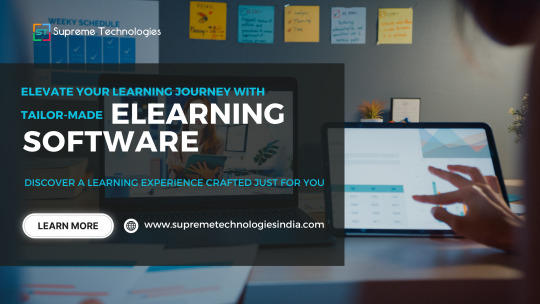
The approach for learning is changing faster than ever. There is no longer traditional classrooms are the only option. All credit to technology, eLearning is turning education. Whether it’s a business, school, or individual, more people are turning to eLearning software to create meaningful online learning experiences. Think of it as a tool that brings all kinds of learning to life, from courses and training programs to interactive lessons. This shift isn’t just about convenience—it’s about making education more accessible and engaging for everyone, wherever they are.
Shape the Future with eLearning Software
Learning is personal, and so are the needs of today’s learners and organizations. eLearning software isn’t just about delivering information—it’s about creating meaningful, personalized experiences that actually help people grow. It’s flexible, intuitive, and designed to adapt to whatever goals you're chasing. It’s learning, made for you.
Personalized Learning: Tailored Just for You
Learning should feel like it’s made for you, and that’s exactly what custom eLearning does. It moves away from the old one-size-fits-all approach and gives you something personal, something that adapts to your pace, style, and goals. Whether you need extra time or like to move quickly, custom eLearning fits into your life, making learning easier and more effective. It's all about giving you what you need, when you need it.
Flexibility: Learning That Fits Your Life
Life is busy, and learning should fit into your schedule—not the other way around. With custom eLearning software, you can dive into your courses whenever it works for you, whether you’re balancing work, family, or other commitments. It’s designed to be there when you need it, making learning easier, more convenient, and accessible for everyone. Learn at your pace, on your time.
Engagement: Making Learning Interactive and Fun
Engagement is key to effective learning. Custom eLearning software goes beyond static content to incorporate interactive elements that capture learners’ attention. From gamified modules to interactive quizzes, these features make the learning process more engaging and enjoyable.
Scalability: Growing with Your Needs
As organizations and educational institutions evolve, so do their training and learning needs. Custom eLearning software offers the scalability to grow alongside these changes. Whether you’re expanding your training program or updating content to reflect new developments, custom solutions can adapt to meet your evolving requirements.
Implementing eLearning Software in Your Organization
Adopting eLearning software involves more than just choosing the right platform. It requires a thoughtful approach to ensure that the software aligns with your educational goals and integrates seamlessly with existing systems. Here are some tips for a successful implementation:
Assess Your Needs: Identify the specific needs of your learners or organization to select an eLearning software that offers the required features and capabilities.
Customize Content: Tailor the content and learning paths to meet the unique needs of your audience. This customization ensures that the learning experience is relevant and impactful.
Integrate with Existing Systems: Ensure that the eLearning software integrates smoothly with any existing Learning Management Systems (LMS) or other tools used within your organization.
Provide Support: Offer training and support to users to facilitate a smooth transition to the new platform and maximize its effectiveness.
Factors to learn While eLearning Software Development
One must need proper guidance from top industry experts to build eLearning software.There are dynamic factors you need to remember for eLearning software development.
User Experience (UX)
One of the important factors to keep in mind is User Experience (UX). No matter what size of the app is, the user interface as well as user experience will be important to capture the user’s attention.
Compatibility
Before the start of the development process, ask developers to consider the basic principles of software development. For that, the developing team should make sure the app runs efficiently on both operating systems.
Security
As a business owner, you must protect the user data no matter what layer of security is required. Since eLearning software has vast students' or teachers’ data, the developing team needs to build software security as well.
Scalability
eLearning software should have the ability to accommodate small or large size content data. Also, the team should ensure it keeps performing at the optimum level regardless of how many users access the app.
Analytics
The eLearning software is incomplete without reports and analytics to gauge the performance and usage. It is another thing to keep in mind while developing because you will need user behavior and engagement data after some stages.
The Path Forward: Embrace Custom eLearning Solutions
The role of custom eLearning solutions in shaping the future of education and training cannot be overstated. These tailored platforms offer a level of personalization, flexibility, and engagement that traditional methods simply cannot match. Whether you’re an organization looking to enhance training programs or an educational institution seeking to innovate teaching methods, custom eLearning software provides the tools you need to succeed.
Conclusion
Are you ready to take your learning experience to the next level? Learn more about how custom eLearning solutions can transform your educational approach here. Explore the possibilities and see how these innovative tools can make a difference for you.
Visit Supreme Technologies for more information and to get started with custom eLearning solutions. Let’s revolutionize learning together!
#custom elearning solutions#eLearning software#eLearning solutions#Elearning Software Development#Elearning Development Services
0 notes
Text
How Instructional Design Services Enhance Employee Learning and Development
In today’s fast-paced corporate environment, employee learning and development are critical for business success. Organizations are increasingly turning to instructional design services to create effective, engaging, and impactful training programs. Whether it’s onboarding new employees or upskilling the existing workforce, effective instructional design ensures that learning is structured, goal-oriented, and tailored to meet business needs.
Companies like 42 Design Square specialize in eLearning development solutions that enhance employee learning experiences, leading to better retention, productivity, and overall job performance.
What is Instructional Design and Why is it Important?
Instructional design is the process of systematically developing educational programs using proven learning theories, strategies, and technologies. It focuses on delivering content in a way that improves comprehension and application in real-world job scenarios.
Here’s why businesses should invest in effective instructional design:
✅ Enhanced Learning Outcomes: Well-structured training programs improve knowledge retention and skill application. ✅ Higher Engagement: Interactive learning keeps employees motivated and involved. ✅ Cost-Effective Training: Digital training reduces the need for expensive in-person sessions. ✅ Scalability: Online courses can be rolled out to employees across locations effortlessly.
Key Benefits of Instructional Design Services
1. Customized Learning Solutions
Every organization has unique training needs. Instructional design services help in creating tailored training programs that align with business goals and employee roles. 42 Design Square specializes in developing content that is personalized for specific industries, job functions, and skill levels.
2. Improved Knowledge Retention
One of the biggest challenges in corporate training is ensuring employees remember and apply what they learn. Effective instructional design incorporates engaging elements such as:
Microlearning modules for easy consumption
Interactive quizzes and assessments
Gamification to make learning fun and rewarding
3. Incorporating eLearning Development Solutions
Digital learning is the future of corporate training. eLearning development solutions leverage technology to create:
📌 Video-based training for visual learners 📌 Scenario-based learning to apply knowledge in real-life situations 📌 Mobile-friendly courses for learning on the go
42 Design Square integrates the latest instructional technologies to provide high-quality, accessible, and engaging training programs.
4. Performance Tracking and Analytics
Modern instructional design services include built-in tracking systems that allow businesses to monitor employee progress. Learning Management Systems (LMS) and analytics tools provide insights into:
📊 Completion rates 📊 Assessment scores 📊 Areas needing improvement
With data-driven insights, companies can continuously refine their training programs for better results.
5. Cost and Time Efficiency
Developing in-house training programs can be time-consuming and expensive. Outsourcing instructional design services to experts like 42 Design Square saves both time and resources while ensuring high-quality training solutions.
Why Choose 42 Design Square for Instructional Design Services?
42 Design Square is a leading provider of eLearning development solutions, offering customized, engaging, and results-driven training programs. Their effective instructional design approach ensures that employees gain the knowledge and skills needed for career growth and business success.
If you’re looking to enhance employee learning and development, investing in professional instructional design services is the key to building a skilled and high-performing workforce. Let 42 Design Square help you create training programs that drive real impact!
0 notes
Text
Learning Management Systems for Employee Training

Learning Management Systems (LMS) have transformed how companies deliver training, making it easier to enhance workforce skills and productivity in today's rapidly evolving business world, where effective employee training is critical for organizational success and maintaining a competitive edge.
Take the first step in revolutionizing your employee training. Contact us today to learn how a Learning Management System can empower your workforce. Reach out at [email protected] and let’s explore this opportunity together!
This guide explores Learning Management Systems for employee training, providing insights and tips to maximize the benefits of this technology-driven solution.
Learning Management Systems for Employee Training: An Overview
A Learning Management System (LMS) is software that facilitates the administration, delivery, and tracking of organizational training programs. Through a centralized platform, employees can access learning materials, participate in courses, and monitor their progress, making it an indispensable tool for modern training initiatives.
LMS platforms offer features like content management, assessments, certifications, and reporting, streamlining the entire training process for organizations.
Key Benefits of Learning Management Systems
Implementing an LMS for employee training provides significant advantages for both employers and employees. Here are some of the most impactful benefits:
Increased Accessibility and Flexibility: LMS platforms allow employees to access training materials on their own schedule, from any device, including computers, tablets, or smartphones. This flexibility ensures employees can engage with training content without interrupting their daily workflow.
Tailored Learning Paths: Organizations can create personalized training programs based on employee needs. By analyzing performance data, individualized learning paths are developed to target specific roles and skill levels, improving engagement and retention.
Centralized Training Management: LMS systems eliminate the need for scattered training files. By storing everything in one central location, companies can efficiently upload, update, and distribute training materials. This centralization ensures consistent training across the organization and simplifies tracking employee progress.
Interactive and Engaging Learning Experiences: LMS platforms use multimedia elements like videos, quizzes, and simulations to create an interactive learning experience. This dynamic approach keeps employees engaged and helps reinforce learning.
Real-time Progress Tracking: LMS platforms enable companies to track employee progress in real-time. Detailed reports and analytics help identify skill gaps, evaluate training effectiveness, and guide decision-making to optimize employee development.
Unlock the full potential of your workforce with our state-of-the-art Learning Management Systems. Don’t miss out on this opportunity to enhance employee skills and productivity. Contact us today to schedule a consultation and start transforming your training programs.
Best Practices for LMS Implementation
To successfully implement an LMS for employee training, follow these best practices:
Define Clear Objectives: Establish your organization’s training goals and align them with overall business objectives. Identifying the key skills and knowledge your employees need will guide you in selecting the right LMS and maximizing your return on investment.
Choose the Right LMS: With many LMS options available, it’s essential to find one that fits your organization’s needs. Evaluate factors such as ease of use, scalability, customization, and customer support. Engage key stakeholders in the decision-making process to ensure you select the best system.
Design Engaging Content: To maximize engagement, develop visually appealing, interactive training content. Use multimedia elements like videos and interactive modules to create an immersive learning experience. Content should be concise, relevant, and designed with adult learning principles in mind.
Encourage Employee Participation: Incorporate collaborative elements like discussion forums or virtual classrooms to promote social learning. Involving employees in the learning process fosters a sense of community and enhances knowledge sharing.
Provide Ongoing Support: Offer continuous support during and after the LMS implementation. Ensure employees are comfortable with the system by providing training sessions, tutorials, and a helpdesk for technical support.
Ready to transform your employee training and boost productivity? Contact us today to discover how Learning Management Systems can drive your organization’s success. Let’s take your workforce to the next level together!
Conclusion: Embrace the Power of LMS for Employee Training
In today’s dynamic business environment, Learning Management Systems have become essential for organizations aiming to enhance employee skills and productivity. By offering accessibility, personalization, centralized management, and real-time tracking, LMS platforms provide a comprehensive training solution.
Successfully implementing an LMS requires clear objectives, the right system, engaging content, active participation, and continuous support. By following these best practices, companies can foster a culture of continuous learning and growth, empowering their workforce to succeed.
Ready to elevate your employee training with the latest tools and techniques? Contact us today to learn how a Learning Management System can take your workforce to the next level. Get in touch now at [email protected] or call us at 866-706-7283 Ext 2.
#Learning Management Systems#LMS#Employee Training#Corporate Training#eLearning#Learning And Development#Workplace Training#Online Training#Training Solutions#Ed Tech#Training Management
0 notes
Text
How Can Custom eLearning Development services Help Your Business?
Explore top eLearning development services to create engaging and effective online learning experiences. Our experts offer custom solutions for your educational needs. For more information visit our website www.infoprolearning.com.
1 note
·
View note
Text
0 notes
Text
SEVnest: Workforce Training Solution for Regulatory Compliance and Upskilling

In today’s fast-changing business environment, companies must ensure their employees stay compliant with regulations and continuously enhance their skills. SEVnest offers a comprehensive workforce training solution that helps businesses achieve both regulatory compliance and employee upskilling efficiently.
Why SEVnest Workforce Training Matters
Regulatory Compliance — Industries like healthcare, finance, manufacturing, and IT require employees to follow strict regulations. SEVnest ensures employees understand and adhere to legal and safety requirements, reducing risks of penalties and non-compliance.
Employee Upskilling — As technology evolves, employees need continuous learning to stay competitive. SEVnest’s training programs enhance productivity, efficiency, and career growth opportunities.
Key Features of SEVnest Training Solution
Customized Learning Paths — Tailored courses to meet industry-specific regulations and employee skill levels.
Online and On-Demand Training — Flexible e-learning options allow employees to train at their own pace.
Certification and Tracking — Automated tracking ensures compliance records are up to date.
Interactive and Engaging Content — Videos, quizzes, and simulations make learning effective and engaging.
AI and Data Analytics — Personalized training recommendations based on employee progress.
Benefits of SEVnest for Businesses
✔ Reduces Compliance Risks — Avoids legal troubles and improves workplace safety. ✔ Boosts Employee Performance — Well-trained employees work efficiently and adapt to new challenges. ✔ Enhances Employee Retention — Growth opportunities keep employees motivated and engaged. ✔ Increases Business Competitiveness — A skilled workforce helps companies stay ahead in the market.
Conclusion
With SEVnest, businesses can streamline compliance training and provide employees with continuous learning opportunities. Investing in the right training solution not only ensures regulatory compliance but also empowers employees with the skills needed for long-term success.
For More Details : https://www.sevnest.com/
Contact us: +91 638 375 5273 [email protected]
#best hr compliance software#corporate elearning solutions#HR Compliance E-learning Solutions#Human Resource Software Solution#HR Compliance Courses With Certificate#Workforce training solutions#Best online compliance training platforms#Regulatory compliance training#Customizable corporate training programs#Workforce development programs#Cybersecurity Awareness Training
0 notes